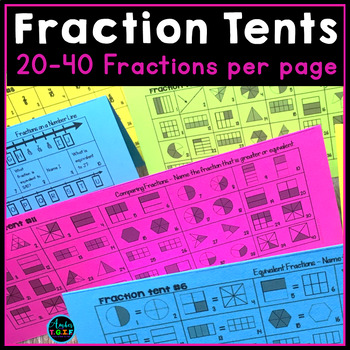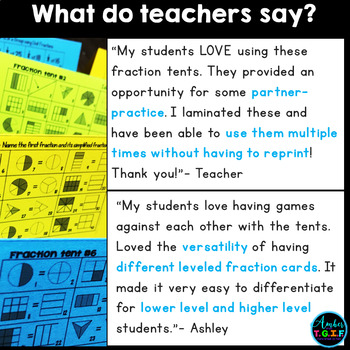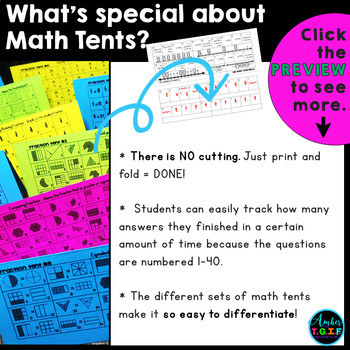Fraction Review & Practice Identifying, Comparing, Equivalent Fractions & More
- PDF
What educators are saying
Description
These easy to use Fractions Tents are NO PREP, engaging activities to help students master fractions! These FUN, engaging worksheet alternatives allow students to practice fractions with an interactive approach.
** Watch the VIDEO PREVIEW above to get a better idea of how Math Tents work! **
I have started using fraction tents because:
* Repeated practice helps my students become more confident with fractions.
* There is NO cutting. Just print and fold = done!
* There are 20-40 fractions activities per page (plus 20-40 answers per page), so huge savings on paper and ink
* Easy to reuse again and again, so you save on copies.
* Did I mention there is NO cutting involved?!!!!?
* Students can easily track how many answers they finish and then try again later to see improvement.
* These fractions tents make the perfect addition to your center rotations. Can be used as a partner check or self-check center.
* Excellent for differentiation.
What topics are addressed?
Identifying fractions (2 sets)
Fractions on a # Line
Equivalent Fractions (2 sets)
Comparing Fractions (2 sets)
Simplifying (Reducing) Fractions (2 sets)
Fractions as Whole Numbers (2 sets)
Parts of a Group
How do they work? Fold the paper on the line so partners that are facing each other can see one side each. One partner will solve the fractions activities for one minute while the other partner checks their answers. They should answer from left to right (since the problems are numbered). If they miss any answers, their partner is to respond, “try again.” Partners may help each other when they are stuck. When the one minute is up, have students make note of the number that they finished. Switch jobs (one “answers”, while the other is the “checker”). Then both try again and try to beat THEIR OWN previous score.
Related Products
Fact Fluency Tents FREE Sample (no more flash card)
Subtraction Fact Fluency Tents
Multiplication Fact Fluency Tents
_________________________________________________________________
➽ Be the first to know about my new discounts, freebies and product launches ➽
▶️ Follow Amber from TGIF on TpT
▶️ Follow Amber from TGIF on Facebook
_________________________________________________________________
** Don't forget that leaving feedback earns you points toward FREE TPT purchases. **
_________________________________________________________________
#Ambers50offof16
Copyright ©Amber from TGIF
Permission to copy for single classroom use only.
Please purchase additional licenses if you intend to share this product.





